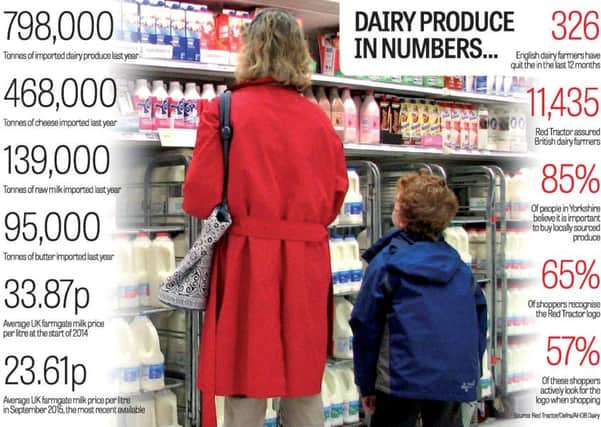Clearly British campaign: Confusion reigns where shoppers must have clarity


Shoppers need to be able to make decisions at a glance. Go during peak times or with young children in tow and having the time to read small print on packaging is nigh on impossible.
And even more impossible given the array of labels on dairy products which leave even the consumer committed to buying British struggling.
Advertisement
Hide AdAdvertisement
Hide AdConfusing it certainly is. And cheese is just the tip of the iceberg.
The clearest products on the shelves were those which showed the Red Tractor logo - currently the only label that guarantees a dairy product is made only with British milk by cows milked in Britain to high welfare standards.
Other products admirably showcased their local origins, cottage cheese with a Union flag and the word ‘Milk’ beneath it, crème fraîche ‘Supporting British Family Farms’ - but no explicit statement they contained 100 per cent British milk.
Without this and in the absence of the Red Tractor on a label, how can a shopper buy with confidence in the product’s origins?
Advertisement
Hide AdAdvertisement
Hide AdStandards of clarity differed hugely, even on ‘own brand’ products on the same shelves.
Frozen products containing cheese offered little or no detail at all.
A yoghurt with ‘Produced in the UK’ on the packaging, also had two of the oval shaped ‘health marks’ - both stating ‘UK’.
It may seem on first glance it is British - and it may be - but none of this information guarantees where the milk used to make the yoghurt is from.
Advertisement
Hide AdAdvertisement
Hide AdVerifying the processing locations indicated by the health marks - which are nothing even to do with the origin of the raw ingredients - required an internet search.
Download a spreadsheet on the Food Standards Agency website and you then scroll down to match up the codes.
Hardly a job for the time-pressed shopper.
On the frozen aisles it got worse. A home brand three-cheese garlic bread had no description of its origins whatsoever, nor did a big brand deep pan pizza.
Without clarity across the full range of dairy products, intentionally shopping for products of a particular origin is a minefield.
Advertisement
Hide AdAdvertisement
Hide AdIan Macalpine, chairman of the Royal Association of British Dairy Farmers, said: “Many consumers are hugely supportive of British agriculture and are aware of the contribution they can make by buying British in terms of the maintaining the countryside, animal welfare and a sustainable rural economy.
“It is vitally important that consumers are provided with clear and honest country of origin labelling so they can make an informed choice and this should be clear throughout the supply chain from the farm gate to the plate, whether it is in the home, shop or restaurant.”
There has been positive action by retailers, showing some progress on the issue. This summer, Leeds-based supermarket chain Asda said it was rolling out ‘Made with British milk’ labelling on its cheese products and new in-store communication to encourage customers to buy British dairy products.
The new labelling supports Asda’s commitment to source its own-label Cheddar using 100 per cent British milk from Arla, while Iceland approached Red Tractor to get the label on its fresh cheese at the start of the summer.
Advertisement
Hide AdAdvertisement
Hide AdA voluntary code drawn up by industry supports clear labels but The Yorkshire Post believes this does not go far enough.
A spokesperson for the British Retail Consortium said: “UK retailers were the first industry to roll out the country of origin principles. Retailers frequently review labelling of their products and respond to customers’ demands.”
Red Tractor’s chief executive David Clarke said there is room for improvement: “If you buy Red Tractor products you can be absolutely certain that it has been made with British milk, whether that is butter, cheese or liquid milk. Any other origin labelling is inadequate, vague and unclear, and not well adhered to.”
For more reporting on our Clearly British campaign, click here.
And sign our petition calling for clear dairy labelling here.